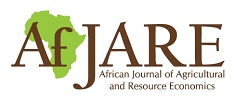African Journal of Agricultural and Resource Economics
(AfJARE)
Journal Africain d’Économie Agricole et des Ressources
(JAEAR)
Published by the African Association of Agricultural
Economists (AAAE)
Volume 13, No. 2
The Government of the Republic of Zambia (GRZ) has reformed the implementation of the Farmer Input Support Programme (FISP). The objective of FISP is to increase competitiveness in the agricultural sector among all key players (input suppliers, agro-dealers, banks, etc.), while improving farmers’ welfare.
Using a non-experimental cross-sectional dataset of 471 households, we evaluate the impacts of satellite collection points (SCPs) under the Purchase for Progress (P4P) initiative implemented by the World Food Programme (WFP) on storage decisions and crop income from maize sales among smallholder farmers in Uganda.
Smallholder rural farmers are exposed to diverse idiosyncratic and covariate shocks that lead to high income and consumption volatility. Formal cash management tools, which are important for managing risk and volatility, often break down due to high information asymmetries and the transaction costs of operating in rural areas.
Many governments adopt agricultural policies that affect production incentives across commodities. In addition, severe market failures in the form of high marketing margins often lower the prices that farmers receive.
While a large body of literature documents the existence of informal arrangements to share risk across and within households, there has been little research on the various coping strategies through which risk sharing takes place, and how these strategies function.
The recent increase in farmland investments in developing countries by private equity funds, large multinationals and sometimes foreign governments has attracted widespread attention and strong emotions from various interest groups.
L’Afrique Subsaharienne n'a pas assez bénéficié des grandes révolutions connues du monde agricole qui ont permis d’accroitre les productivités. Malgré l’existence des nouvelles technologies, les niveaux des productivités agricoles demeurent faibles et inférieurs à ceux d’autres régions en développement.
